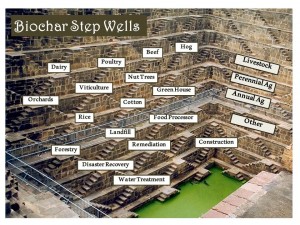I was recently introduced to the concept of step wells while reading the latest issue of “The Intelligent Optimist”. Step wells are magnificent manmade structures most commonly found in India. These deep water wells sometimes contain thousands of steps and date back more than 2,000 years. Since part of my brain seems to have turned into biochar over the past few years [i.e. high carbon, adsorptive, sequestering all manner of charcoal trivia, etc.] the picture of course reminds me of the cascading uses of biochar concept, first articulated by the Ithaka Institute (download a great presentation on it here).
Cascading information was a familiar concept in my previous life in corporate America, but the idea of cascading uses was new to me. The gist of the idea is that something can be used multiple times before it finds its ultimate end use or final resting place. [It’s a bit like the notion of ‘trickle-down economics’ except biochar cascades actually make economic sense ;-)!]
As I’ve delved into the economic impact of using biochar within different agricultural settings, I am increasingly convinced that biochar cascades are the best approach to building a viable biochar market. The current price of biochar is still relatively high which makes the business case a tough sell if you are ‘just’ using it to increase crop yield. The math just doesn’t work for many cropping systems. Let’s take corn and soybeans as a few examples since these crops make up a huge percentage of US farm land. In a good year these crops will gross less than $1K per acre (e.g. CORN: 2013 average was ~159 bushels per acre * $4 per bushel = $632/acre; SOYBEAN 2013 average was ~43 b/acre * $9.50 per b = $409) after much hard work, increasing expenses plus the stress of watching Mother Nature throw all manner of curve balls year after year. Adding even one ton of biochar would not only wipe out profits, but it would turn profits into losses. To break even, assuming you were able to find biochar at $600 per ton, you’d need to nearly double corn yields. [Most studies show that far more than one ton per acre is needed for yields to increase in most soils.] I wish it were otherwise but yield increase alone is not going to sell biochar, at least for most annual cereal crops in US soils (vegetables might be a very different story as is using biochar in severely depleted soils such as in Africa).
But with the cascade model, the economics of biochar begin to look very, very promising. There are a growing number of biochar cascades that are only now being identified so this notion of a Biochar Step Well with multiple cascades which all ultimately lead down into the earth might be a great metaphor for creating a successful biochar industry. Much work needs to be done to validate and quantify the benefits for each of the different cascades, but that is beginning to happen and I’m excited to be a part of it!


